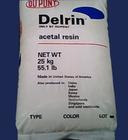CAMPUS® datasheet | Delrin® 525GR NC000
This datasheet of Delrin® 525GR NC000 from DuPont Engineering Polymers is provided by the international plastics database CAMPUS.
This datasheet includes:
Rheological properties - Mechanical properties - Thermal properties - Electrical properties - Other properties - Rheological calculation properties - Diagrams
Delrin® 525GR NC000 | POM-GF25 | DuPont Engineering Polymers Product Texts
ISO 9988: POM-H,MNR,4-3,GF25
Common features of Delrin® acetal resin include mechanical and physical properties such as high mechanical strength and rigidity, excellent fatigue and impact resistance, as well as resistance to moisture, gasoline, lubricants, solvents and many other neutral chemicals. Delrin® acetal resins also have excellent dimensional stability and good electrical insulating characteristics. They are naturally resilient, self-lubricating and available in a variety of colours and speciality grades.
The good melt stability of Delrin® acetal resin normally enables the recycling of properly handled production waste. If recycling is not possible, DuPont recommends, as the preferred option, incineration with energy recovery (-17 kJ/g of base polymer) in appropriately equipped installations. For disposal, local regulations have to be observed.
Delrin® acetal resin typically is used in demanding applications in the automotive, domestic appliances, sports, industrial engineering, electronics and consumer goods industries.
Delrin® 525GR is a 25% glass fibre reinforced, medium viscosity acetal homopolymer for injection molding.
Design guide
Food compliance:
Not compliant for EU
Typical applications:
Gears, fuel applications and parts requiring very high strength and stiffness.
top
Rheological properties Value Unit Test Standard
Melt volume-flow rate, MVR 5 cm³/10min ISO 1133
Temperature 190 °C ISO 1133
Load 2.16 kg ISO 1133
Molding shrinkage, parallel 0.5 % ISO 294-4, 2577
Molding shrinkage, normal 1.2 % ISO 294-4, 2577
top
Mechanical properties Value Unit Test Standard
Tensile Modulus 9500 MPa ISO 527-1/-2
Stress at break 140 MPa ISO 527-1/-2
Strain at break 3 % ISO 527-1/-2
Tensile creep modulus, 1h 8500 MPa ISO 899-1
Tensile creep modulus, 1000h 6000 MPa ISO 899-1
Charpy impact strength, +23°C 55 kJ/m² ISO 179/1eU
Charpy impact strength, -30°C 66 kJ/m² ISO 179/1eU
Charpy notched impact strength, +23°C 8 kJ/m² ISO 179/1eA
Charpy notched impact strength, -30°C 8 kJ/m² ISO 179/1eA
top
Thermal properties Value Unit Test Standard
Melting temperature, 10°C/min 178 °C ISO 11357-1/-3
Temp. of deflection under load, 1.80 MPa 170 °C ISO 75-1/-2
Temp. of deflection under load, 0.45 MPa 175 °C ISO 75-1/-2
Coeff. of linear therm. expansion, parallel 40 E-6/K ISO 11359-1/-2
Coeff. of linear therm. expansion, normal 100 E-6/K ISO 11359-1/-2
Burning Behav. at 1.5 mm nom. thickn. HB class IEC 60695-11-10
Thickness tested 1.5 mm IEC 60695-11-10
UL recognition UL - -
Burning Behav. at thickness h HB class IEC 60695-11-10
Thickness tested 0.8 mm IEC 60695-11-10
UL recognition UL - -
top
Electrical properties Value Unit Test Standard
Relative permittivity, 100Hz 3.7 - IEC 60250
Relative permittivity, 1MHz 3.8 - IEC 60250
Volume resistivity 1E12 Ohm*m IEC 60093
top
Other properties Value Unit Test Standard
Water absorption 1.3 % Sim. to ISO 62
Humidity absorption 0.15 % Sim. to ISO 62
Density 1580 kg/m³ ISO 1183
top
Rheological calculation properties Value Unit Test Standard
Density of melt 1350 kg/m³ -
Thermal conductivity of melt 0.29 W/(m K) -
Spec. heat capacity melt 2530 J/(kg K) -
top
Diagrams |
 |
|

